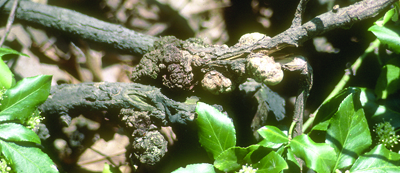Crown gall
July 30, 2015
Cause
Agrobacterium tumefaciens (bacterium)

Galls, shown here on euonymus, can range in size from about pea-sized to golf-ball size or larger. Galls start out spongy, and cream or green colored and become dark and woody with age.
Hosts
Creeping euonymus, rose, willow, and poplar are particularly susceptible. This bacterium produces tumor-like growths on plant crowns, branches, and roots.
Management
Remove and destroy severely affected plants. Galled parts can be pruned off; disinfest tools frequently when pruning. Avoid replanting susceptible plants in areas where infected plants have been removed. The bacterium enters through wounds and can persist in the soil for many years after infected plants are removed. A commercially available biological control agent, Agrobacterium radiobacter, can be used as a dip or spray to treat bare root plants, such as roses, before planting.
Print a PDF of this page: Crown gall.



 Print
Print Email
Email
